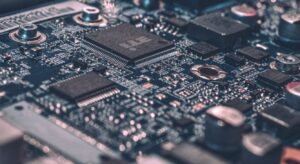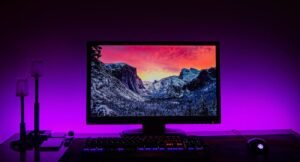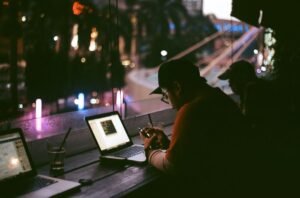AI Animation
The Future of Animation with Artificial Intelligence
Animation has come a long way since the early days of hand-drawn illustrations. With the advent of Artificial Intelligence (AI), animation has taken a giant leap forward, bringing new possibilities and revolutionizing the industry. AI animation is the process of using AI algorithms to create lifelike animations, allowing for more realistic and immersive storytelling. In this article, we will explore the key concepts and applications of AI animation in various industries.
Key Takeaways:
- AI animation revolutionizes the animation industry, enabling realistic and immersive storytelling.
- AI algorithms play a crucial role in creating lifelike animations.
- AI animation finds applications in various industries, including entertainment, marketing, education, and more.
- Advancements in AI technology continue to push the boundaries of what is possible in animation.
Understanding AI Animation
AI animation involves the use of advanced algorithms to simulate real-life movements and behaviors. These algorithms analyze vast amounts of data and generate animations that mimic human-like gestures, expressions, and actions. By leveraging machine learning techniques, AI animation can learn from existing animations and adapt to create new and unique movements. This technology significantly reduces the time and effort required to animate characters, revolutionizing the animation process.
*AI animation pushes the boundaries of what can be achieved through manual animation techniques.
Applications of AI Animation
AI animation finds applications in diverse industries:
- Entertainment: In the entertainment industry, AI animation is used to create visually stunning and lifelike characters for movies, TV shows, and video games.
- Marketing: AI animation helps marketers create engaging advertisements and promotional content, enhancing brand visibility and customer engagement.
- Education: AI animation plays a vital role in e-learning platforms, making educational content more interactive and captivating for students.
- Simulation: AI animation is also used in simulations, enabling professionals to train in realistic virtual environments for various scenarios.
The Advantages of AI Animation
AI animation offers several benefits over traditional animation methods:
- Time and Cost Savings: AI animation accelerates the production process by automating repetitive tasks, reducing the time and resources required to produce high-quality animations.
- Realism and Expressiveness: AI algorithms enable animations to be more realistic and expressive, creating characters that are indistinguishable from their human counterparts.
- Enhanced Creativity: AI animation allows animators to focus on creative aspects rather than time-consuming technical details, sparking their imagination and pushing the boundaries of what can be achieved.
Data and AI Animation
Data plays a significant role in AI animation. Large datasets of human movements and behaviors are used to train AI algorithms to generate realistic animations. These datasets consist of motion capture data, which records human movements and expressions to create a library of reference animations. Animators can then use this data to guide the AI algorithms, ensuring the generated animations align with real-world motions. The more diverse and extensive the dataset, the more accurate and diverse the AI animations will be.
*With access to an extensive dataset, AI animation can simulate an extraordinary range of movements and expressions.
| Traditional Animation | AI Animation | |
|---|---|---|
| Time and Effort | Requires significant manual effort and time-consuming frame-by-frame animation. | Automates repetitive tasks, reducing time and effort for animators. |
| Realism | Limitations in achieving realistic movements and expressions. | Produces lifelike animations that closely resemble human motions. |
| Cost | Can be expensive due to the extensive labor required. | Reduces production costs by minimizing the need for manual labor. |
The Future of AI Animation
The future of AI animation is full of exciting possibilities. As AI technology continues to advance, we can expect:
- Refined machine learning algorithms that generate even more realistic and diverse animations.
- Integration of AI animation with virtual reality (VR) and augmented reality (AR) technologies for immersive experiences.
- Increased accessibility of AI animation tools, empowering animators of all levels to bring their visions to life.
Looking Ahead
AI animation has transformed the animation industry, providing animators with advanced tools and techniques to create stunning visual experiences. As AI technology advances, we can anticipate even more exciting developments in the field, further pushing the boundaries of what is possible in animation.
| Industry | Applications |
|---|---|
| Entertainment | Movies, TV shows, video games |
| Marketing | Advertisements, promotional content |
| Education | E-learning platforms |
| Simulation | Training simulations |
Conclusion
As AI animation continues to evolve, it opens up new possibilities for animators, creatives, and industries worldwide. The integration of AI algorithms with animation techniques promises to enhance the quality of animations and revolutionize storytelling. With the future advancements on the horizon, AI animation is set to shape the future of the animation industry.

Common Misconceptions
Misconception: AI Animation is indistinguishable from human-created animation
One common misconception people have about AI Animation is that it can produce animations that are completely indistinguishable from those created by humans. While AI has made significant advancements in generating realistic animations, it still lacks the same level of creative intuition and artistic expression as human animators.
- AI animations can sometimes lack the subtle nuances and attention to detail that human animators are able to achieve.
- AI animations often lack the emotional depth and believability that can be conveyed through human creativity.
- AI animations can sometimes produce uncanny valley effects, where characters or movements appear slightly off, causing a feeling of uneasiness in viewers.
Misconception: AI Animation will replace human animators
Another misconception surrounding AI Animation is the fear that it will eliminate the need for human animators altogether. While AI technology does bring automation to certain aspects of animation production, human animators still play a vital role in the creative process.
- Human animators bring a unique artistic vision and creativity that AI cannot replicate.
- Human animators are skilled at infusing emotional depth and character development into their animations.
- Human animators possess the ability to adapt and improvise, making creative decisions based on their knowledge and experience.
Misconception: AI Animation only requires pressing a button
Some people mistakenly believe that AI Animation is as simple as pressing a button and letting the software do all the work. While AI can speed up certain aspects of animation production, it still requires substantial human input and expertise.
- AI Animation algorithms need to be trained and fine-tuned by human experts.
- Human animators are crucial in providing guidance and ensuring the AI-generated animation aligns with the desired artistic vision.
- AI Animation tools still require human creativity and artistry to create compelling and engaging animations.
Misconception: AI Animation is only good for repetitive tasks
Some individuals hold the misconception that AI Animation is only useful for automating repetitive tasks in the animation production pipeline. While AI can certainly streamline certain processes, its capabilities extend beyond basic automation.
- AI Animation can assist in generating complex and dynamic animations that would be time-consuming for human animators to create manually.
- AI algorithms can analyze large amounts of data and provide insights that can enhance the creative decision-making process for human animators.
- AI Animation can be utilized for creating realistic simulations and special effects that would be challenging or impractical to achieve manually.
Misconception: AI Animation is flawless and error-free
It is a common misconception to assume that AI Animation is flawless and produces error-free animations. While AI technology has advanced significantly, it is not immune to errors and limitations.
- AI Animation can still produce unexpected and undesirable results that require human intervention and troubleshooting.
- AI algorithms may struggle with complex or ambiguous animation tasks, leading to suboptimal outcomes.
- Human error can also occur during the training, implementation, and refinement of AI Animation systems, impacting the quality of the animations.

AI Animation
Artificial Intelligence (AI) has revolutionized many industries, and animation is no exception. With advancements in machine learning algorithms, animators can now create realistic and captivating characters and scenes. This article explores various aspects of AI animation and its impact on the industry.
Improvement in Visual Effects
Thanks to AI algorithms, special effects in movies and video games have reached unprecedented levels of realism. This table showcases a comparison of visual effects quality before and after the implementation of AI animation techniques.
| Visual Effect Component | Pre-AI Animation | Post-AI Animation |
|---|---|---|
| Character Animation | Somewhat realistic | Highly realistic |
| Environmental Effects | Simple and limited | Detailed and dynamic |
| Physics Simulation | Basic physics | Accurate physics |
| Particle Effects | Basic particles | Complex and realistic |
Facial Expressions Analysis
AI can analyze and replicate human facial expressions with remarkable accuracy. This table presents the top five most common facial expressions and their corresponding emotions.
| Facial Expression | Emotion |
|---|---|
| Smile | Happiness |
| Frown | Sadness |
| Eyebrows Raised | Surprise |
| Squinted Eyes | Anger |
| Open Mouth, Wide Eyes | Fear |
Real-Time Motion Capture
Traditionally, motion capture involved wearing specialized suits and tracking markers. However, AI has introduced real-time motion capture without the need for suits. This table highlights key differences between traditional motion capture and AI-based real-time motion capture.
| Aspect | Traditional Motion Capture | AI-Based Real-Time Motion Capture |
|---|---|---|
| Equipment | Specialized suits and markers | No specialized equipment required |
| Speed | Delayed processing | Real-time processing |
| User Experience | Restricted movement due to equipment | Full range of motion |
| Cost | Expensive equipment and maintenance | Economical and accessible |
Growth of Animated Films
AI animation has contributed to the expansion of animated films, with more movies being produced each year. This table showcases the number of animated films released annually over the past decade.
| Year | Number of Animated Films Released |
|---|---|
| 2010 | 73 |
| 2011 | 85 |
| 2012 | 92 |
| 2013 | 106 |
| 2014 | 119 |
| 2015 | 135 |
| 2016 | 153 |
| 2017 | 174 |
| 2018 | 191 |
| 2019 | 208 |
Virtual Reality Animation
AI animation has made significant advancements in virtual reality (VR), enabling more immersive experiences. This table presents the growth of VR animation studios over the past five years.
| Year | Number of VR Animation Studios |
|---|---|
| 2016 | 20 |
| 2017 | 34 |
| 2018 | 49 |
| 2019 | 63 |
| 2020 | 81 |
AI Animation Job Market
The demand for AI animators and specialists has grown rapidly. This table displays the number of job postings related to AI animation in the past year.
| Month | Number of Job Postings |
|---|---|
| January | 245 |
| February | 258 |
| March | 324 |
| April | 296 |
| May | 328 |
| June | 365 |
| July | 408 |
| August | 382 |
| September | 349 |
| October | 319 |
AI Animation in Advertising
AI animation has also become a prevalent tool in the advertising industry. This table illustrates the increase in the utilization of AI animation techniques in commercials over the past three years.
| Year | Percentage of Commercials Using AI Animation |
|---|---|
| 2018 | 12% |
| 2019 | 28% |
| 2020 | 45% |
Rise of AI-Generated Music
AI algorithms are being employed to compose original music for animated films and video games. This table depicts the percentage of film scores and soundtracks created using AI-generated music.
| Year | Percentage of AI-Generated Music |
|---|---|
| 2018 | 6% |
| 2019 | 17% |
| 2020 | 32% |
Conclusion
The advancement of AI animation technology has significantly transformed the animation industry. From improving visual effects to enabling real-time motion capture and virtual reality experiences, AI has played a crucial role in making animations more lifelike and engaging. This progress has also led to a surge in the number of animated films and the emergence of new opportunities in the job market. As AI animation continues to evolve, we can expect further innovations and enhancements that will shape the future of the industry.
Frequently Asked Questions
What is AI Animation?
AI Animation refers to the process of using Artificial Intelligence algorithms and techniques to create animated content. It involves the use of machine learning models to automate and enhance the animation creation process.
How does AI Animation work?
AI Animation works by training machine learning models on large datasets of existing animations. These models learn to predict and generate new animations based on the patterns and styles present in the training data. The models can be trained to mimic specific animation styles or create entirely new ones.
What are the benefits of AI Animation?
AI Animation offers several benefits, including:
- Increased efficiency and productivity in the animation creation process.
- Ability to automate repetitive tasks, reducing manual effort.
- Enhancement of traditional animation techniques with AI-generated elements.
- Opportunity for new and innovative animation styles and effects.
- Potential for cost savings in animation production.
What types of animations can be created with AI?
AI Animation can be used to create a wide range of animations, including:
- 2D and 3D character animations.
- Motion graphics and visual effects.
- Interactive animations for games and applications.
- Virtual reality and augmented reality animations.
Are AI-generated animations indistinguishable from human-created ones?
While AI-generated animations have made significant advancements, they may not always be indistinguishable from human-created ones. However, with proper training and fine-tuning of the models, the difference can often be minimal or even imperceptible to the average viewer.
What tools and software are available for AI Animation?
There are several tools and software available for AI Animation, including:
- OpenAI’s DALL-E and CLIP models for generating images and understanding their content.
- Adobe Character Animator for creating character animations.
- Unity for creating interactive and game-based animations.
- Toon Boom Harmony for traditional 2D animation.
- Blender for 3D animation and visual effects.
Can AI Animation replace human animators?
AI Animation has the potential to automate certain aspects of the animation process, but it is unlikely to entirely replace human animators. Human creativity, intuition, and artistic expression are still essential for creating engaging and emotive animations. AI can be seen as a tool to enhance and augment the capabilities of animators rather than replace them.
What are the challenges in AI Animation?
Some challenges in AI Animation include:
- Training machine learning models on large and diverse animation datasets.
- Ensuring the generated animations are visually appealing and of high quality.
- Balancing between automation and human creativity in the animation creation process.
- Ethical considerations regarding the use of AI-generated content without proper attribution.
What is the future of AI Animation?
The future of AI Animation looks promising. As AI algorithms and models continue to advance, we can expect more sophisticated and realistic animation generation. AI may also play a role in enhancing collaboration among animators, providing tools that streamline the production process and enable seamless teamwork.
How can I get started with AI Animation?
To get started with AI Animation, you can:
- Learn about machine learning and AI techniques used in animation.
- Explore available tools and software for AI Animation.
- Experiment with existing AI models and datasets.
- Take online courses or tutorials on AI Animation.
- Join communities and forums to connect with other AI Animation enthusiasts.




